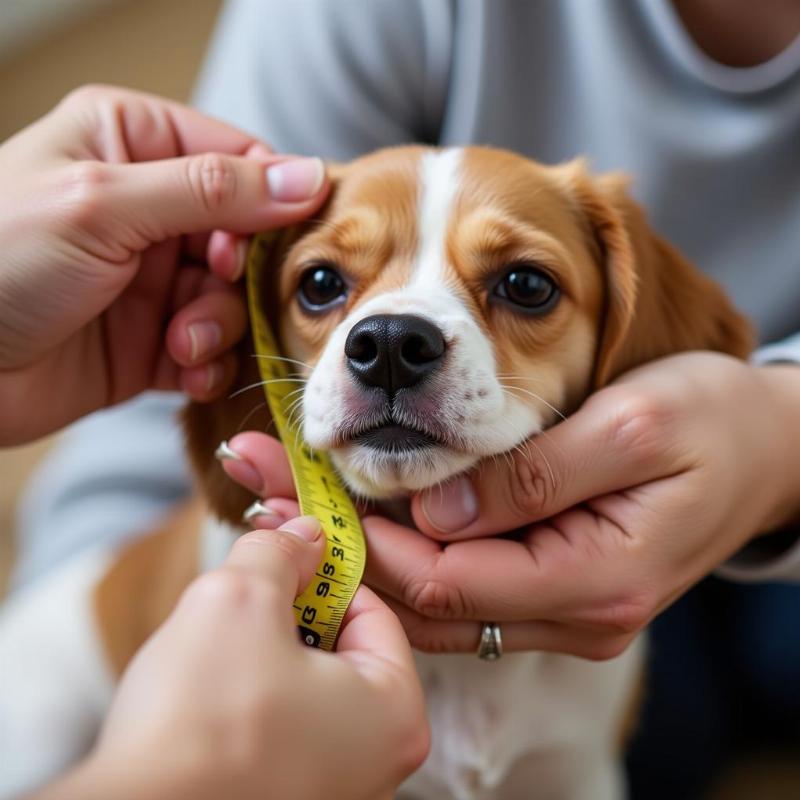Dog halters are becoming increasingly popular, especially for small dog owners in the US. They offer a gentle yet effective way to manage pulling and improve training, making walks more enjoyable for both you and your furry friend. But with so many options on the market, finding the right halter for your small dog can feel overwhelming. This article will guide you through everything you need to know about dog halters for small dogs, helping you choose the perfect one for a safe and comfortable walking experience.
Why Choose a Halter for Your Small Dog?
Traditional collars can put pressure on a small dog’s delicate trachea, potentially leading to choking or other health issues. Halters, on the other hand, distribute pressure more evenly across the head and shoulders, providing greater control without the risk of choking. This is particularly beneficial for small breeds prone to breathing problems like pugs or French bulldogs. Halters also discourage pulling by gently redirecting your dog’s head when they strain on the leash. This makes them a valuable tool for training, helping your small dog learn to walk politely by your side.
Types of Dog Halters for Small Dogs
Several types of halters are available, each with its unique design and benefits. The most common types include:
- Head Collars: These resemble a horse halter and fit around the dog’s muzzle and behind the ears. They offer excellent control and are especially effective for strong pullers.
- Front-Clip Halters: These halters clip to the leash at the front of the dog’s chest. This design discourages pulling by gently turning the dog towards you when they strain on the leash.
- No-Pull Halters: These halters typically combine features of head collars and front-clip halters, providing maximum control and pull reduction.
Choosing the Right Size and Fit
A properly fitted halter is crucial for your small dog’s comfort and safety. Measure your dog’s snout circumference and refer to the manufacturer’s sizing chart to ensure a snug but not restrictive fit.
 Measuring Dog Snout for Halter Fitting
Measuring Dog Snout for Halter Fitting
Introducing Your Small Dog to a Halter
Introducing a halter gradually is essential to ensure a positive experience for your small dog. Start by letting your dog sniff and investigate the halter. Reward them with treats and praise. Next, gently put the halter on for short periods, gradually increasing the duration as your dog becomes comfortable.
Training with a Dog Halter
Once your small dog is comfortable wearing the halter, you can begin leash training. Keep training sessions short and positive, using treats and praise to reinforce good behavior. training leashes for dogs that pull can be beneficial during this process. Avoid jerking or pulling on the leash, as this can cause discomfort and discourage your dog from walking.
Common Questions About Dog Halters for Small Dogs
Are halters safe for small dogs?
Yes, halters are generally safe for small dogs when used correctly. They offer a more humane alternative to traditional collars, especially for breeds prone to breathing problems.
Can a halter hurt my small dog?
A properly fitted halter should not hurt your small dog. Ensure the halter is not too tight and avoid jerking or pulling on the leash.
How do I choose the right size halter for my small dog?
Measure your dog’s snout circumference and consult the manufacturer’s sizing chart.
Are there any breeds that shouldn’t wear a halter?
Certain brachycephalic breeds may require specialized halters. Consult your veterinarian for recommendations.
Conclusion
Dog halters provide a safe and effective way to manage pulling, improve training, and enhance your walking experience with your small dog. By choosing the right type and size and introducing the halter gradually, you can ensure a comfortable and enjoyable walking experience for both you and your furry friend. Remember to consult with your veterinarian or a professional dog trainer if you have any concerns or questions.
FAQ
- How tight should a dog halter be? You should be able to fit two fingers comfortably between the halter and your dog’s skin.
- Can I leave a halter on my dog all the time? No, halters are designed for walking and training and should not be left on unsupervised.
- What if my dog rubs his face with the halter? This could indicate an improper fit. Adjust the halter or try a different style.
- Can I use a halter on a puppy? Yes, halters can be used on puppies, but make sure to choose a size and style appropriate for their age and breed.
- Are halters effective for all dogs? While halters are generally effective, some dogs may require other training tools or methods.
- What is the difference between a halter and a harness? A halter focuses on head control, while a harness distributes pressure across the chest and back. best dog training collar for small dogs may also be an alternative.
- Where can I buy a dog halter? Dog halters are available at most pet stores and online retailers.
Beautdogs.us is your premier online destination for comprehensive dog care information, breed-specific guidance, and access to the finest products designed to enhance your dog’s well-being. Whether you’re a seasoned dog owner or just starting your journey with a canine companion, Beautdogs.us offers expert advice and resources to help you navigate every aspect of dog ownership. From training tips and nutritional guidance to product reviews and breed insights, we’re committed to providing a trusted source of information for the modern dog lover. Contact us at [email protected] or +1 501-555-7529.